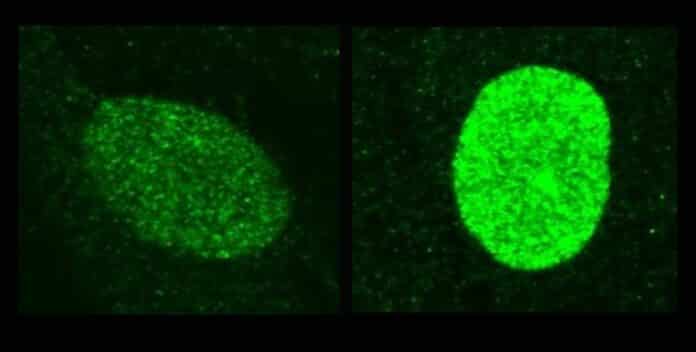Herpes simplex virus (HSV) is widespread and affects nearly two-thirds of people worldwide, says the World Health Organization. When HSV enters the body, it stays inactive and sometimes becomes active again, causing painful blisters around the nose and mouth. While it’s just annoying for most people, it can lead to severe eye infections, brain inflammation, and even life-threatening infections in newborns.
Researchers have known for a long time that the virus and the immune system are constantly fighting each other. But why do some people keep the virus in check while others get serious infections?
But more importantly, how does the fight happen inside our cells? Researchers have been trying to figure this out to find ways to treat and prevent infections.
A recent study from Harvard Medical School, using lab-engineered cells and published in PNAS, reveals precisely how our cells and viruses battle for control. The research also explains how our immune system checks the virus at the cell’s control center — the nucleus.
Immune signaling proteins send out a call to action. New research uncovers a crucial role played by a set of proteins called interferons. These proteins gather other protective molecules, preventing the virus from taking over.
When the herpes simplex virus (HSV) enters the body, it multiplies by creating copies of itself inside cell nuclei, using the host’s genetic machinery. To succeed, the virus must outsmart the immune system. However, the strategies employed by the virus and the immune system in this battle have yet to be discovered, making it challenging to develop effective medicines.
Interferons, named for their ability to interfere with pathogens, are signaling molecules released when the immune system detects microbes like viruses. These signals activate genes that produce proteins, which then block viruses from establishing infections.
While we know how interferons combat viruses in the cytoplasm (the gel-like substance within cells), their methods against DNA viruses attacking within the cell nucleus have remained a mystery.
Study senior author David Knipe, the Higgins Professor of Microbiology and Molecular Genetics at the Blavatnik Institute at HMS, said, “We know a lot about how interferon and immune stimulants work against viruses in the cytoplasmic body of the cell, but up until now, we knew very little about how the immune system blocks viral infection in the cell’s nucleus. Our findings define the mechanisms of action of any treatment that induces interferons and how they can prevent and treat infections from HSV, other herpesviruses, and nuclear DNA viruses.”
Insights from this research could help scientists understand and potentially develop treatments for other DNA viruses found in the nucleus. These troublesome viruses include Epstein-Barr (causing mononucleosis), human papillomavirus, hepatitis B, and smallpox.
The study defines how interferon treatments and other tested therapies like toll-like receptor ligands work against herpesvirus diseases. New activators like cGAS agonists may also induce herpes resistance through these newly understood mechanisms, the researchers suggest.
However, the scientists emphasize that potential therapies for herpes and other DNA viruses are currently just ideas. Before reaching humans, these approaches need testing in small animals like mice and larger animals.
“In a recent study led by Knipe and co-author Catherine Sodroski, it was discovered that a host protein called IFI16 plays a crucial role in blocking the herpes simplex virus (HSV) from reproducing. IFI16, recruited by interferon, employs various tactics to prevent the virus from spreading.
One strategy involves IFI16 creating a protective shell of molecules around the viral DNA, acting like a ‘bubble wrap.’ This prevents the virus from activating its genes and making copies of itself. However, the virus fights back by producing VP16 and ICP0 molecules, which remove the protective wrapping and allow it to reproduce.
IFI16 also neutralizes the virus-produced VP16 and ICP0. Under normal conditions, there’s some IFI16 present in the cell nucleus, but it’s not enough to counter the virus. When interferon signals prompt higher levels of IFI16, the immune system gains the upper hand.
These findings suggest that elevated levels of IFI16 in clinical samples indicate successful control of symptoms related to HSV-2, shedding light on the molecular mechanisms that prevent outbreaks.
Using Lab Discoveries to Improve Health: Knipe’s interest in herpesviruses began in college during his recovery from mononucleosis, turning curiosity into a career.
The Knipe lab investigates what happens at the molecular and cellular levels during symptomatic and dormant herpes simplex virus (HSV) infections, focusing on the host immune system’s response. Knipe applies these insights to explore using HSV genetic material for vaccines against HIV, SARS, West Nile, and anthrax.
For Knipe, unraveling the puzzles of how viruses interact with the host cell nucleus and immune system is endlessly fascinating. Applying this knowledge to fight diseases is rewarding, and he emphasizes that there’s much more to discover in this ongoing battle.
In conclusion, the study sheds light on how the immune system battles against herpes to protect the body. The research highlights the crucial role of interferons, signaling proteins that activate protective measures, such as creating a ‘bubble wrap’ around the viral DNA. The immune system’s ability to recruit proteins like IFI16 prevents the virus from reproducing.
These findings not only advance our understanding of herpes but also open doors for potential treatments and further exploration of similar strategies against other viruses. The ongoing quest to unravel the complexities of this battle holds promise for future breakthroughs in enhancing our immune defenses.
Journal reference:
- Catherine N. Sodroski and David M. Knipe, Nuclear interferon-stimulated gene product maintains heterochromatin on the herpes simplex viral genome to limit lytic infection. PNAS. DOI: 10.1073/pnas.2310996120.
